Colourful synergy – When Massimo Vignelli worked for Venini
Recently we published an article on Fungo, a hand-blown mushroom-shaped glass table lamp, and also the first cooperation between Massimo Vignelli and Venini. Now we would like to show you some other exceptional results of the collaboration between traditional craftsmanship and unique talent.
-
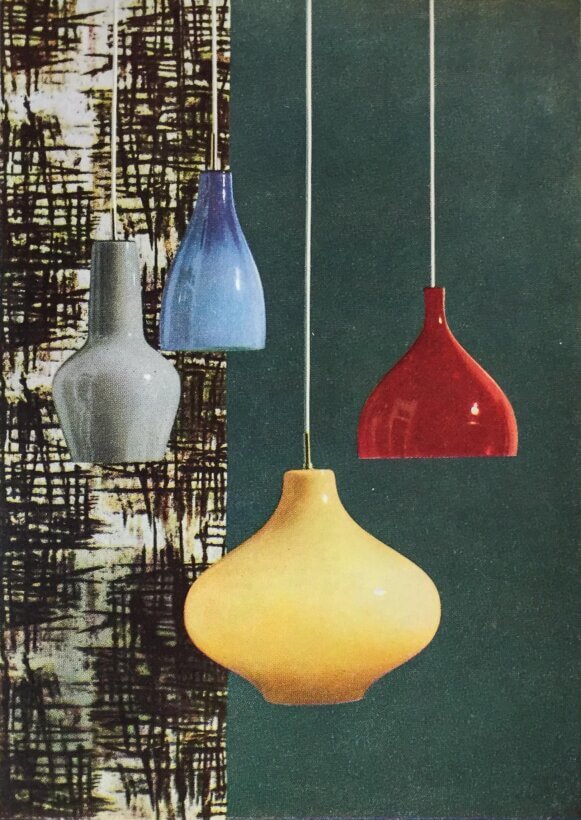 Various models by Massimo Vignelli for Venini (source: Indoor Catalogue No. 62 - Part A, from the Palainco archive).
Various models by Massimo Vignelli for Venini (source: Indoor Catalogue No. 62 - Part A, from the Palainco archive).
-
For those not familiar with Venini we will start with a brief introduction.
Paolo Venini founded Venini on the Venetian island of Murano in 1925. Over time the company has become one of the most important and famous glassblowing factories in the world, perhaps even the most renowned one. The company epitomises the joint venture between highly skilled craftsmen and innovative designers. Venini’s success lies in his reinterpretation of traditional schemes, his openness towards new artistic trends and long-term experience in manufacturing.
Since its foundation Venini has worked with leading international artists and designers, like Fulvio Bianconi, Tobia Scarpa and his father Carlo Scarpa, Tyra Lundgren, Tapio Wirkkala, Ettore Sottsass and… Massimo Vignelli.
-
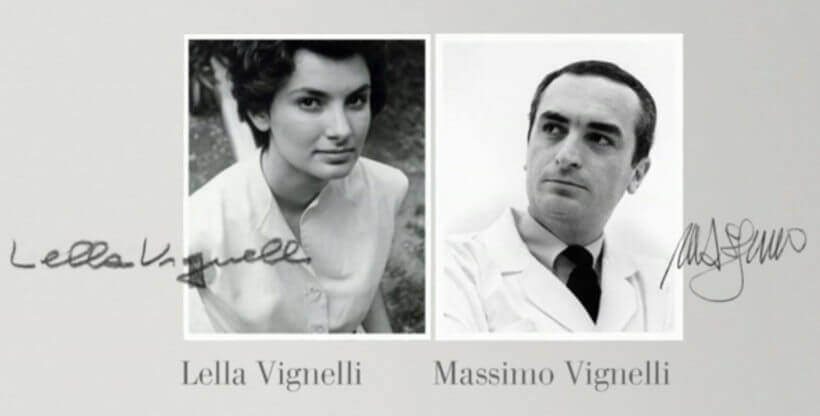 Lella and Massimo Vignelli at the beginning of their careers (source: Unknown).
Lella and Massimo Vignelli at the beginning of their careers (source: Unknown).
-
Though the achievements of the Italian born designers Massimo Vignelli (1931-2014) and his wife Lella Vignelli (1934) are also world-famous, their name is not as well known as the company name Venini.
Massimo and Lella Vignelli designed, among many others identities, for international corporations including American Airlines, Benetton and Knoll, the subway sign system for the New York Metro, packaging design for Fratteli Rossetti and IBM, architectural graphics for the Guggenheim Bilbao and the Museum of Fine Art in Minneapolis, furniture design for Poltrona Frau and Casigliani and product design for Heller and lighting manufacturers Arteluce and … Venini.
-
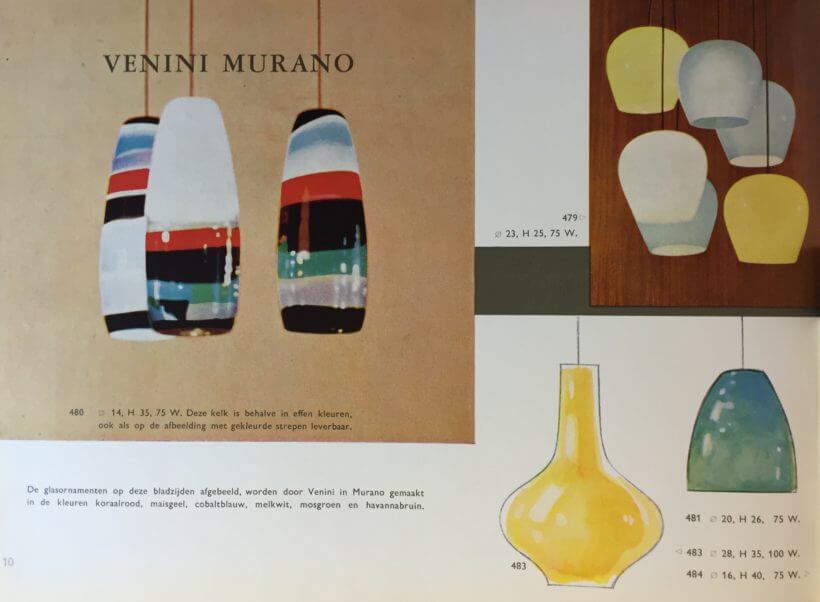 Apparently it was not worth mentioning Vignelli’s name in the early 1960s yet…
(source: Page from catalogue 58 by Dutch lighting company Indoor, from the Palainco archive).
Apparently it was not worth mentioning Vignelli’s name in the early 1960s yet…
(source: Page from catalogue 58 by Dutch lighting company Indoor, from the Palainco archive).
-
In the 1950s, when Massimo Vignelli was still a student at the Università di Architettura in Venice, Paolo Venini offered him the opportunity to design glass-blown lamps. Vignelli’s first design was Fungo, the stunning and elegantly curved, mushroom-shaped silhouette (on which we wrote an article earlier). Those five years Vignelli worked for Venini left us with many other striking lamps to represent his early experience in design.
Massimo Vignelli said of the collaboration: “Venini was a glorious company that took Murano glass out of kitsch and projected it into the 20th century. Through the years the company had several architects design glass, in itself a completely new phenomenon. In the past, glass was crafted by the master blower directly, without the contribution of a real designer. Venini changed all that and commissioned some of the best architects of the time.” (Source: ‘Vignelli from a to Z’).
-
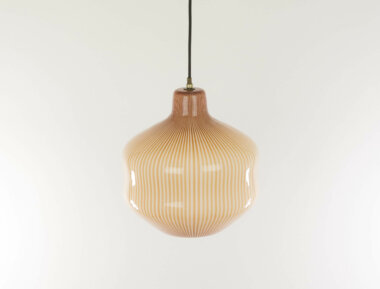

-
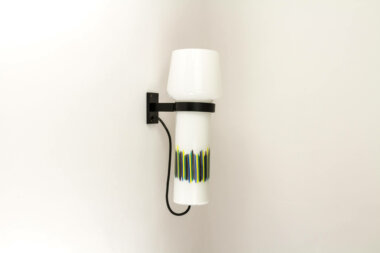 Some excellent examples designed by Massimo Vignelli during his period at Venini (source: Palainco).
Some excellent examples designed by Massimo Vignelli during his period at Venini (source: Palainco).
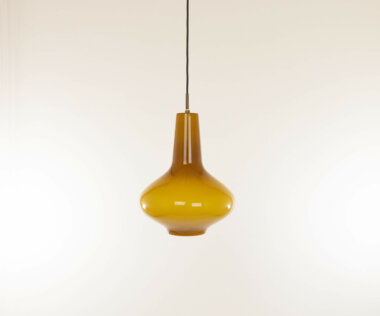
-
At Venini Massimo Vignelli learned all about glass and craftsmanship, but he especially “…learned about the role of light on our perception of objects”.
Again Massimo Vignelli, in ‘Vignelli from a to Z’: “If the glass is clear, light will go through. If the surface of glass is frosted, the light will be trapped inside, making the glass glow with light. If the surface is smooth, light will have a reflection: if the surface is corrugated, light is refracted in multiple reflections. Without light everything is lifeless.”
Also special about the Venini lamps designed by Massimo Vignelli is the use of colours. Vignelli used colours as “…a secondary manipulation to obtain different modulation of light”. Modulation here refers to a change in the wavelength of the light, in other words Vignelli is talking about the way light changes when it interacts with colour.
-
-
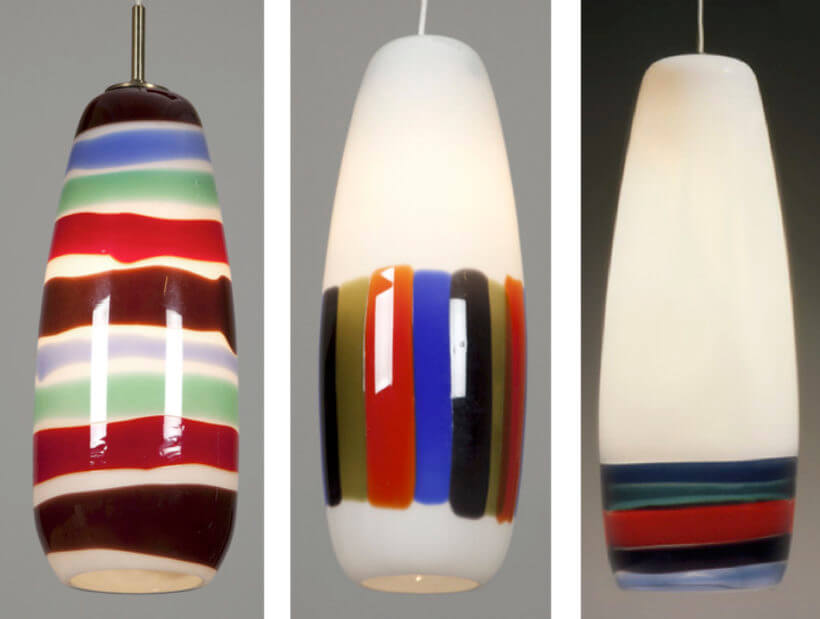 Milk glass lamps with coloured bands, also known as ‘Sigaro’ - 1956 (source: Jacksons).
Milk glass lamps with coloured bands, also known as ‘Sigaro’ - 1956 (source: Jacksons).
-
Vignelli’s introduction on the process of designing and manufacturing is noteworthy as well: “I would go to a master blower with a design. He would take the basic measurements and then proceed to make the object. It was interesting to see the evolution of the shape from a glass blob to a finished object. I must say that many times the forms obtained during the process were better than the final one. That was part of the experience with glass, and its seduction, but it was also a tremendous enrichment of one‘s sensibility and awareness.”
As the pictures show, there is a difference in the appearance of glass lamps when they are switched on or when they are switched off—this is what Vignelli meant by “modulation”. Fortunately you can influence this colour effect yourself by deciding on the strength of the light bulb. As the wattage of the bulb becomes stronger, the colour of yellowish glass, for example, goes from orange to pale yellow.
-
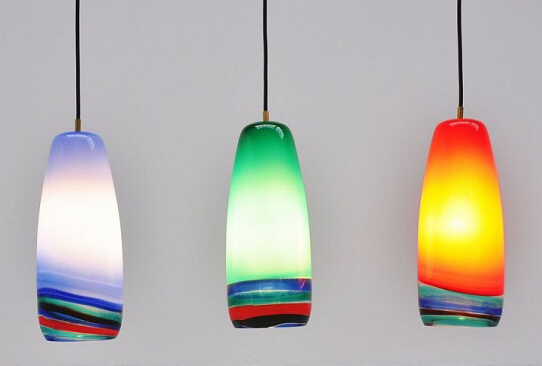 The pendants look genuinely different when switched on… (source: Mass Modern Design).
The pendants look genuinely different when switched on… (source: Mass Modern Design).
-
Massimo & Lella Vignelli shared a vision on design, which guided all their work. In their book The Vignelli Canon they explain the three most important aspects of design. According to the Vignellis design has to be “…semantically correct, syntactically consistent and pragmatically understandable” and as the couple also argues: “If you do it right, it will last forever”!
-
 Massimo Vignelli with the programme designed by Michael Bierut of Pentagram, for the Architectural League President’s Medal event in 2011, where he and his wife Lella received an award (Right, source: Pentagram).
Massimo Vignelli with the programme designed by Michael Bierut of Pentagram, for the Architectural League President’s Medal event in 2011, where he and his wife Lella received an award (Right, source: Pentagram).
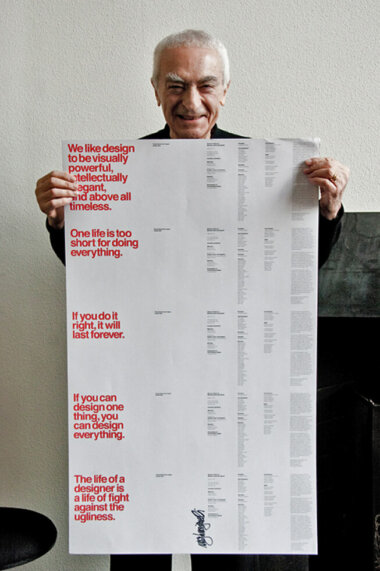
-
According to Michael Bierut, art critic and designer who worked for Vignelli for 10 years, in Domus: “When the pieces finally came together, inevitably no one would be as genuinely delighted as Massimo. And what form of salesmanship is as effective as genuine enthusiasm?”
We hope we managed to express our enthusiasm for these fascinating lamps. If we did, we would like to inform you, in all confidence naturally, that we have some nice pieces in our collection.
If you would like to be the first to read articles on designers and special designs, please subscribe to our newsletter.
-
- Literature: Vignelli from a to Z (Mulgrave, 2007), The Vignelli Canon (www.vignelli.com, 2010), Venini.com & Domus No. 835 (March 2001).
Unless otherwise stated, all material is sourced and/or generated internally. All rights reserved.
- Text: Palainco, Koos Logger & Ingrid Stadler.
- Image sources: Vignelli.com, The Apartment, Jacksons, Mass Modern Design, Pentagram & the Palainco Archive.
The article and its contents may not be copied or reproduced in any part or form without the prior written permission of the copyright holders.
Published on: 14 September 2016